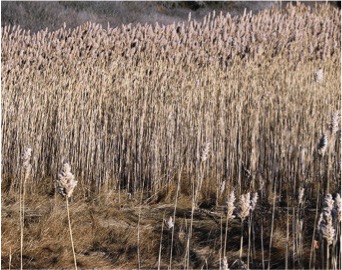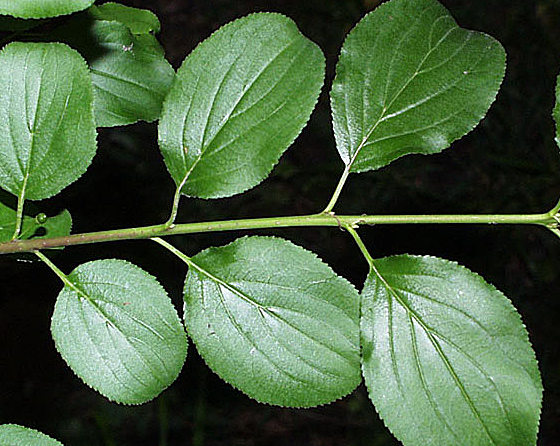
Welcome to Lower Hudson PRISM's Invasives Strike Force EcoQuest Survey page!
Do you love being outdoors and searching for interesting critters and plants in nature? Or maybe you love taking photos when you are out hiking or gardening? Or maybe you just love scavenger hunts! Our EcoQuest surveys allow you to become a part of the action and help us document invasive species in our region while having fun in the process!
To help you build up your knowledge of invasive species in our region, we offer a monthly challenge that keys in on (a) focal invasive species (and sometimes a native plant counterpart). Each month, Lower Hudson PRISM staff will announce a new scavenger hunt-style challenge to find and document an invasive plant or animal (and/or their native counterpart!) by taking and sharing photos via iNaturalist. See below for this month's challenge, instructions, and other past challenges. While you do not have to join our specific project to participate in the challenge, we HIGHLY encourage you to do so. Search for us, Invasives Strike Force EcoQuest , on iNaturalist, and join today to upload your photos directly to our project! Become an official member of our team today!
Hemlock Woolly Adelgid Challenge: February and March 2023
REGISTER NOW!
Help our Hemlocks - Join the HWA Winter Mapping Challenge!
Feb 1 - March 15, 2023
*New to iMap? Watch this video tutorial to set up your NYiMapInvasives Account!
Hemlock woolly adelgid is an invasive forest pest that attaches to the base of hemlock needles (left, or above on mobile phones), ultimately killing the tree. It produces a distinctive cottony-white mass in late fall throughout winter (right, or below on mobile phones). Help us find and report this pest! Photo credit: imapinvasives.org/hwa
Hemlocks are the third most common tree in New York State and are a foundation species in our forests, meaning they create the ecosystem in which they reside. Hemlocks provide essential ecosystem services like preventing soil erosion and promoting good water quality by providing shade and water filtration so that aquatic species in underlying streams and native vegetation in the understory can thrive. They also provide critical habitat for many native species of animals in our region including bald eagles, porcupines, moose and numerous species of arthropods.
The hemlock woolly adelgid (HWA) is an aphid-like invasive forest pest that has already swept through and continues to persist in our region, killing many of our native hemlocks in the Northeast. It uses a piercing mouthpart to feed off of hemlock twigs, essentially clogging up the twig tissue and stopping the flow of important nutrients to the buds, preventing new growth. At this time of year, its presence on hemlock twigs becomes apparent due to a white cottony mass that the insect leaves behind on hemlock twigs near the base of the needle. We need your help in finding hemlocks that show these early signs of HWA while management and control is still an option as well as finding and mapping HEALTHY hemlocks so we can preserve the gene pool and identify any places that the adelgid may not be present!
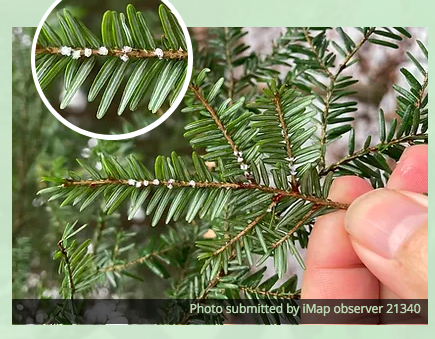
For ID tips and techniques, please see the above picture and caption and be sure to check out this month’s Woolly Bully video for a detailed look at species ID in the field.
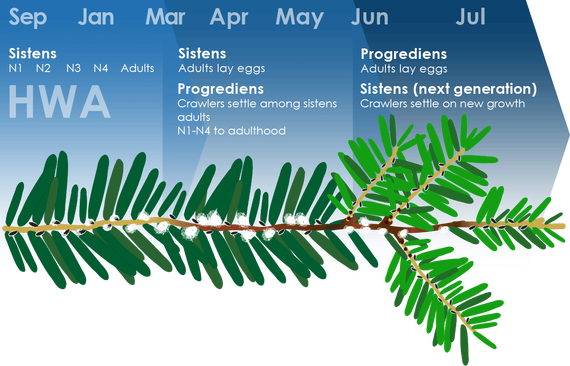
The life cycle of the hemlock woolly adelgid consists of 2 simultaneous generations (sistens or the 1st generation, and progrediens or the 2nd generation) both of which are completed on hemlocks. The sistens generation begins producing a distinctive white, cottony mass on twigs at this time of year and wll continue doing so throughout the winter. Photo credit: https://blogs.cornell.edu/nyshemlockinitiative/
This is fun! How do I stay informed of each month's challenge?
It's simple! Once you've signed up for the EcoQuest Challenge, you will receive notifications about the next month's challenge as the date approaches! If you have any questions or problems, just shoot an email to NY-NJ Trail Conference Stewardship Communications Coordinator, Krysti Sabins, at ksabins@nynjtc.org and she will be happy to help!
Please also visit the NYBG EcoFlora page to learn more about their history of EcoQuest challenges in New York City.
FORMER ECOQUEST CHALLENGES
Minimize Mile-a-minute! Challenge: October 2022
Mile-a-minute is an aggressive vine that grows rapidly–up to 6 inches a day and up to 30 feet in a single year–making it extremely harmful to native species.
When looking for mile-a-minute, keep an eye out for its prickly stems that climb over surrounding vegetation and form dense, tangled mats that shade out underlying plants.
According to New York Invasive Species Information Clearinghouse, Mile-a-minute weed is generally found in natural and man-made disturbed and open areas and along the edges of woods, streams, wetlands, uncultivated fields, and roads. It can also be found in areas with extremely wet environments with poor soil structure. While it will grow in drier soils, mile-a-minute prefers high moisture. It will tolerate some shade for part of the day but prefers full sun.
A few common lookalikes include Arrowhead tearthumb (persicaria sagittata), Halberd-leaf tearthumb (persicaria arifolium), and Bindweed (convolvulus). The main giveaways differentiating mile-a-minute from these plants are its Dorito-shaped leaves and ocrea, or fused stipules - basically, the circular leaves that the stems seem to punch through. If you spot those along with prickly stems, you got yourself a colony of mile-a-minute.
Identification is the first step toward plant control. With your help, we can take steps to manage and control this invasive species!
I want in! How do I get started?
1. Download the iNaturalist App by visiting your phone's app store, or register to use it on iNaturalist.org.
2. Visit iNaturalist's Video Tutorial page which has very clear step by step instructions on how to photograph your target species and upload to the iNaturalist database or check out this 5-part Seek and iNaturalist tutorial we created that provides a detailed and informative introduction to both Seek and iNaturalist.
3. Register here so you receive notice of each month's species.
3. Take photos of this month's EcoQuest challenge target specie(s) by using the iNaturalist app directly (note: this is the easiest way to take and upload photos since your location can automatically be part of your observation)
OR
Take photos of the target specie(s) on your smartphone, then later upload them to the iNaturalist site on your computer.
4. You can either add photos directly to our iNaturalist project Invasives Strike Force EcoQuest or simply upload your photos to the overall iNaturalist database. Our curators will then sort through the posts and add any invasives you found to our project!
5. Keep searching! Your photos will be used to help scientists track the spread of invasives in our region. It's important stuff!
Cut Out Kudzu! Challenge: September 2022
Kudzu is a semi-woody, climbing or trailing, deciduous, perennial vine that climbs to the forest canopy in the pursuit of more light. Kudzu, also known as foot-a-night vine, Japanese arrowroot, Ko-hemp, and “the vine that ate the South”, is a legume and member of the bean family.
Once established, kudzu vines compete with forest trees both for sunlight in the crown and for water and nutrients from the soil. The vines may directly damage colonized trees by strangulation. These physical traits of a kudzu significantly impact the ability of native trees to grow and reproduce, increasing the early mortality of native trees, and preventing the establishment of new trees or shrubs in the dim light below the colonized canopy.
When hunting for kudzu, be on the lookout for its dark green and lobed compound leaves of 3 along long, hairy vines. These vines can blanket areas and cover entire trees, as seen left.
This species favors full sun and can be found in disturbed areas.
Identification is the first step toward plant control. With your help, we can take steps to manage and control this invasive species!
Report Black (& Pale) Swallow-wort! Challenge: August 2022
Black (& pale) swallow-wort are voracious vines that wrap around - or strangle - other plants as well as themselves - thus giving them the lovely name of "dog-strangling vine."
Pale and black swallow-wort look very similar when not in flower. Both species have long, oval, opposite leaves that are green and waxy, measuring about 3-4 inches long by 2-3 inches wide. The leaves of pale swallow-wort tend to be a slightly lighter shade of green than black swallow-wort.
Flowers of both species are small and star-like. Pale swallow-wort has a pink to maroon flower with petals that have a narrow base, whereas black swallow-wort flowers are a deep purple-black and have petals with a wider base.
However, during the month of August, flowers are no longer this plant’s key ID feature. Instead. you’ll be looking for their long, slender seed pods that kind of resemble string beans on a vine.
In terms of habitat, black and pale swallow-wort tolerate a variety of soils and environmental conditions. Swallow-wort favors full sun but may thrive in semi-shaded to densely shaded areas, as seen here. These species are disturbance-and drought-tolerant and can quickly spread once established.
Furthermore, black and pale swallow-wort have similar flowers to milkweed, the primary host plant for monarch butterflies. The swallow-worts have that same star-shaped flower that monarchs often mistake for milkweed when they lay their eggs, but when the eggs hatch there's nothing to eat.
Even if the butterflies don’t lay their eggs on this plant, swallow-wort can easily outcompete the native species once they have a stronghold in an area. Just look at this mono-crop in this shaded woodland. A square meter stand of swallow-wort is capable of producing 1,000-2,000 seeds per year, which are then dispersed by wind. It also releases chemicals into the soil that prohibit the growth of other species!
Identification is the first step toward plant control. With your help, we can take steps to manage and control this invasive species!
June & July 2022 | Japanese spiraea
Japanese spiraea, or spiraea japonica, is also known as Japanese meadowsweet and Korean spiraea, and is native to Japan China and Korea. It is an emerging invasive species in the Lower Hudson region of New York with a few populations located across the state.
Japanese spiraea is a:
- Perennial, deciduous shrub
- Grows to a height of 4-6 feet
- Prefers wetter soil and full sun, though can tolerate partial shade.
To identify Japanese Spiraea, be on the lookout for its eye-catching, rosy-pink flowers in broad clusters at the end of long, alternate-leafed stems. The stem itself is woody, slender and reddish brown, and sometimes hairy, while the leaves are oval-shaped with a toothy edge and are about 1-3 inches in size.
This shrub grows in an upright, low and broadly mounded form, creating a dense thicket of thin wiry stems. This species is especially threatening because it can invade a variety of habitats from wet, riparian areas, to forests, and even fields.
Lookalikes:
White meadowsweet -
Five-petaled white or pinkish flowers
Flowers in cone-shaped clusters.
Steeplebush -
Spike-like clusters of deep pink flowers
Flowers tower above stems
May 2022 | Incised Fumewort
Incised fumewort or Corydalis incisa as you Latin-lovers like to call it, is a biennial, shade-tolerant forb, or herbaceous flowering plant, in the poppy family, related to bleeding-hearts and to the showy garden perennial spring fumewort. Native to eastern Asia, it is uncommon in the horticultural trade, but may spread in soils with shipments of other plants, or be sold as seeds and bulbs for medicinal uses.
While widely distributed, incised fumewort is still uncommon in the mid-Atlantic, making it an early detection species that may still be eradicated by a region-wide rapid response.
This species is typically found in floodplains and along small streams in well-drained soils and habitats and can grow very densely along riverbanks.
To identify this species, keep an eye out for its purple flowers this month. These flowers are vuvuzela-like, about 1/2 inch long. Flowers occur in elongated clusters up to 4 inches long, with 10-16 flowers per bunch.
Leaves of the incised fumewort are quite delicate-looking and sharp-cut, as its name suggests - kind of resembling curly parsley with a reddish edge if you ask this surveyor. They are divided into 3 leaflets, with those leaflets divided into 3 leaflets, with those divided into 3…a tessellation of leaves!
Like the leaves, the stem of this species also has a red tinge to it, making it stand out from lookalikes.
When fruiting, the incised fumewort produces green oblong seed capsules that hang from the ends of the flower stalks; they are less than 1" long and look like itty-bitty string beans. These beans have an eruptive personality, though, and once they mature, explode, launching seeds up to 10 feet!
During this month, also keep an eye out for the native lookalike species, yellow fumewort (C. flavula), which, indeed, has yellow flowers. When not flowering, the two species may also be distinguished by the color of their stems: Incised fumewort stems are reddish at the base; Yellow fumewort stems are green.
April 2022 | Callery Pear
The Callery Pear was first imported into the United States from southeastern Asia in the early 20th century. With its smaller stature and ability to keep on pleasin’ no matter the season (showy white flowers in spring, vibrant leaves in fall), this tricky timber became very popular. You may also know this bad boy by the name Bradford Pear, a cultivar widely planted as a street and ornamental tree in the 1960s.
This tree prefers full sun and has a high tolerance for environmental stressors, allowing it to thrive in fields, roadsides, and along forest edges where it displaces native species.
Not only does it push out natives, but it also disrupts the ecosystem as a whole. While pollinators visit Callery pear flowers, few insects utilize the leaves, which is unfortunate for the many bird species who depend on leaf-feeding caterpillars and other insects to feed their young. Some birds do eat the fruit, but that unfortunately only spreads the seeds farther and wider.
And that’s why we need your help to spot these invaders!
When looking for Callery pear trees, keep an eye out for their teardrop shape, showy white flowers in the early spring, and brightly colored leaves in the fall. At maturity, these trees can reach a height of 30 to 60 feet.
- Look out for leaves that are thick and waxy, and arranged alternately. Leaves are dark green and teardrop-shaped, measuring about 3 inches across. The leaf edge, or margin, is finely crenated, round-toothed, and rippled. In fall, leaf colors range from brilliant reds and maroons to oranges and yellows.
- The bark on young limbs is grayish brown and smooth but becomes scaly as the tree matures.
- Flowers bloom anywhere from February to April and appear with or before the leaves. They consist of clusters of white, five-petaled flowers, about 1 inch across with many maroon-tipped anthers; and let’s not forget to get a whiff of that rancid scent once they fade!
- From June to February, you’ll see persistent clusters of small pears, a quarter to a half-inch across that start out green and become tan or reddish when ripe, covered in speckles, on long stems
Now that you can properly identify this tree, get out there and start reporting them to iNaturliast. Only report trees that aren't planted on purpose or cultivated - lookout for specimens along roadsides, within parks, or at forest edges that have spread from elsewhere.
With your help, we can take steps to manage and control this invasive species!
Think Like Vinca: December 2021 and January 2022
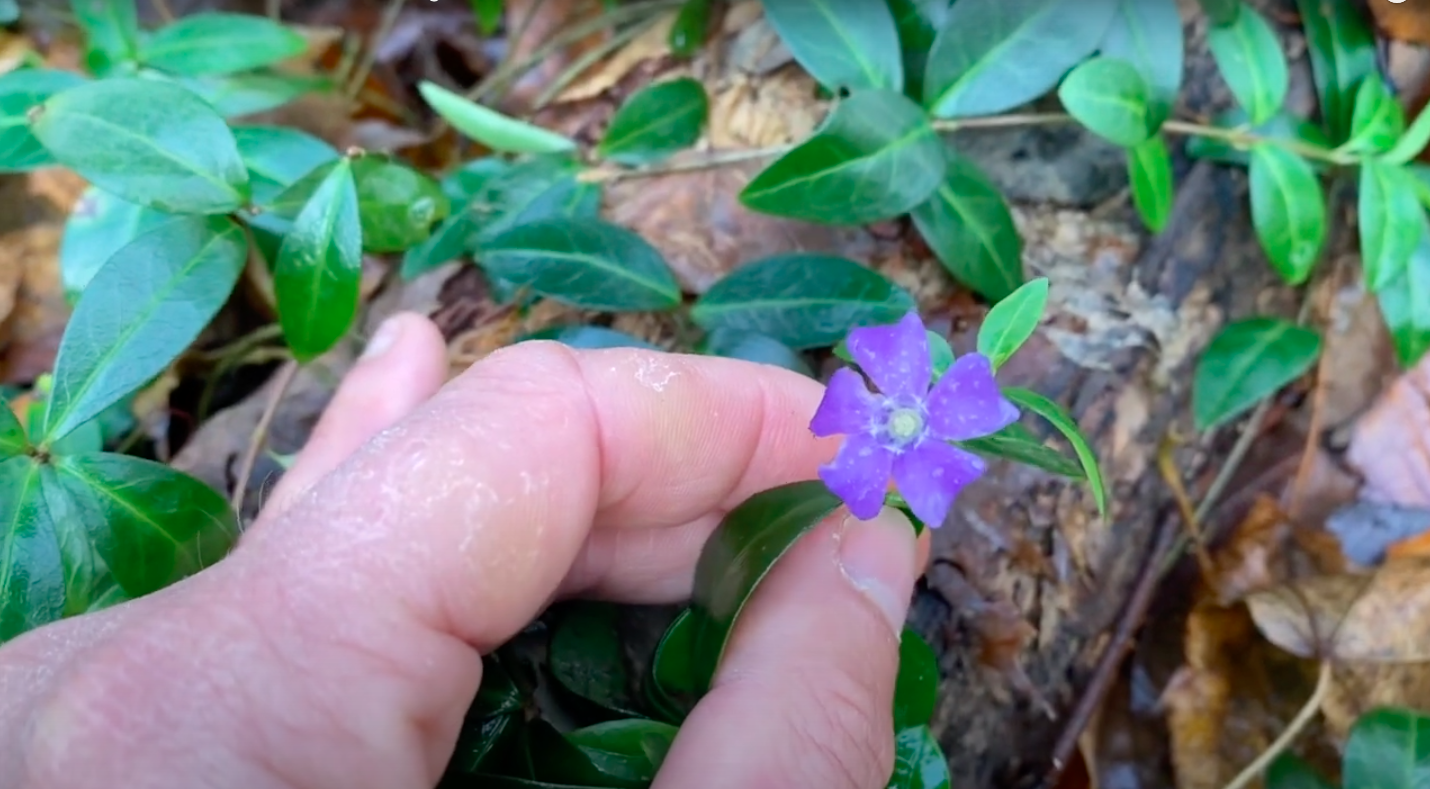
Common or lesser periwinkle, Vinca minor, can be distinguished this time of year by its dark glossy ovate leaves that are arranged opposite of one another along slender, hairless stems. The leaves look a bit like two eyeball shapes coming off the stem where the paired leaves intersect. You may even see its distinctive pinwheel-like purple flowers blooming- even in December! Photo credit: Brent Boscarino
Ready to put on your green thinking caps? This month we are challenging all of our EcoQuest Challenge volunteers to “Think Like Vinca” and head out to search for Vinca minor, lesser or common periwinkle. Vinca was introduced to North America in the 1700’s as an ornamental groundcover species that is still popular today in commercial and residential landscapes due to its hardiness and vigorous growth. Unfortunately, these are the same characteristics that make it a threatening invasive plant once it escapes, quickly sprawling over the ground forming dense patches that outcompete native herbaceous and woody species and preventing tree seedling survival. Vinca primarily spreads through vegetative means through underground runners and fragments and is often found around old homesites and estates or in natural areas where yard waste has been improperly disposed of.
For ID tips and techniques, please see the above picture and caption and be sure to check out this month’s Think Like Vinca video for a detailed look at species ID in the field.
Out With Goutweed: November 2021
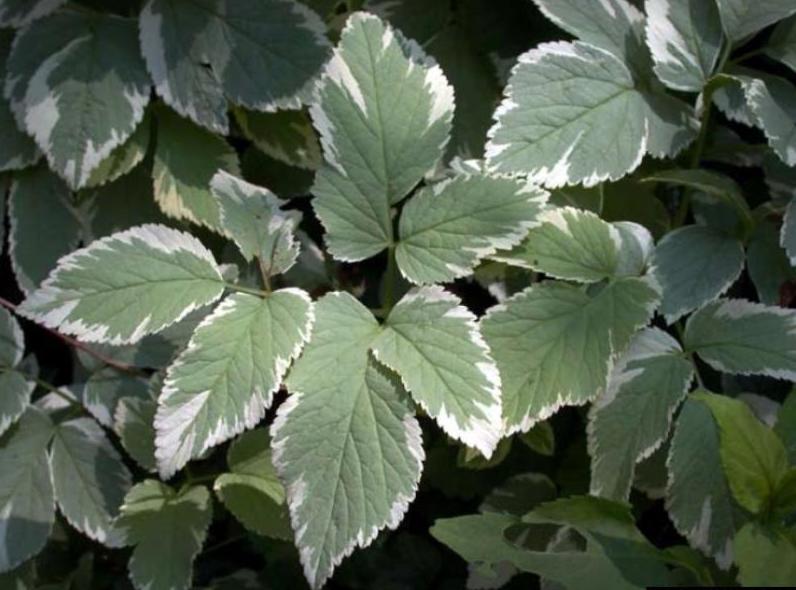
The leaves of goutweed are divided into three groups of three serrated leaflets. Pictured here is the variegated form (white splotches) but wild type goutweed can be all green. Photo credit: Leslie J. Mehroff, University of Connecticut, bugwood.org
A gardener’s scourge. Native groundcover’s nemesis. Bishop’s weed or goutweed, Aegopodium podagraria, is a highly aggressive, creeping herbaceous perennial that can form dense patches even in closed canopied forest environments where it has escaped cultivation, displacing native plants in the process. Goutweed’s primary means of reproduction is through rhizomes, or underground horizontal stems that form dense networks beneath the forest floor, making removal of the species difficult once established. The species is typically spread through accidental or improper yard waste disposal or intentional plantings in parks. Education and outreach is critical in preventing further introductions for these reasons.
Goutweed’s leaves are typically divided into three groups of 3 serrated leaflets, each of which resemble a goat’s foot in shape (the genus, Aegopodium, is from the Greek words “agios” which means goat and “podion” which means little foot). The wild type of goutweed is typically medium green in color but there’s a popularly planted variegated form as well that you may see in escaped environments. In the spring, flowering shoots emerge much taller than the basal leaves that give rise to white flowers arranged in umbels that resemble Queen Anne’s lace.
For a more detailed look at the ID characteristics of goutweed relative to other lookalikes including invasive yellow archangel be sure to check out this field ID video created by Invasive Species Citizen Science Coordinator, Brent Boscarino. To become an EcoQuest surveyor, all you need to do is download an easy-to-use mobile app, iNaturalist, and register here for further instructions. Once iNaturalist is downloaded, you can immediately start photographing and uploading pictures, instantly connecting you to thousands of other citizen scientists just like you!
Storm the Castle/Princess Tree: October 2021
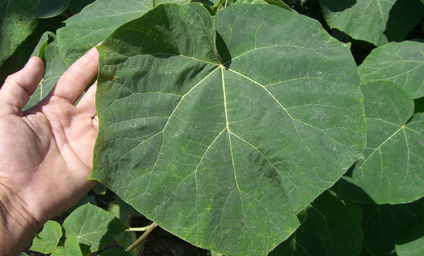
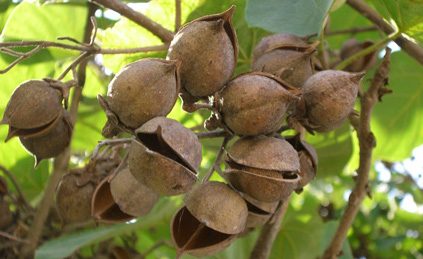
Princess tree leaves are large, heart-shaped and oppositely arranged along the stem- and they are very fuzzy/velvety to the touch, including the newer twigs. The princess tree seed pods are pecan-shaped and contain upwards of 2,000 seeds per pod. Photo credit: projects.ncsu.edu
The princess tree is a member of the Empress tree family (Paulowniaceae) and is a Tier 3, or established invasive plant in the lower Hudson Valley of New York State. It was imported to the United States in the mid-1800's as a fast-growing shade and ornamental tree due to its showy leaves and purple tubular flowers that bloom in the spring. The base of the flowers are surrounded by velvety brown sepals which can persist on the tree even after the flower is done blooming. It thrives in high light conditions along forest edges, roadways, old fields and along riverbanks in our region. It colonizes new areas through root sprout and through prolific seed dispersal via water and wind. It's large heart-shaped leaves are oppositely arranged along the branches and are fuzzy/velvety to the touch, unlike the "look-alike" catalpa tree whose large heart-shaped leaves are typically arranged in whorls of 3 along the branch and are waxier to the touch. The seed pods of the princess tree are pecan-shaped unlike the cigar-like/string bean-like appearance of the seed pods of the catalpa tree.
For a more detailed look at the ID differences between the princess tree and catalpa, check out our Storm the Castle/Princess Tree EcoQuest Challenge field ID video created by citizen science coordinator, Brent Boscarino.
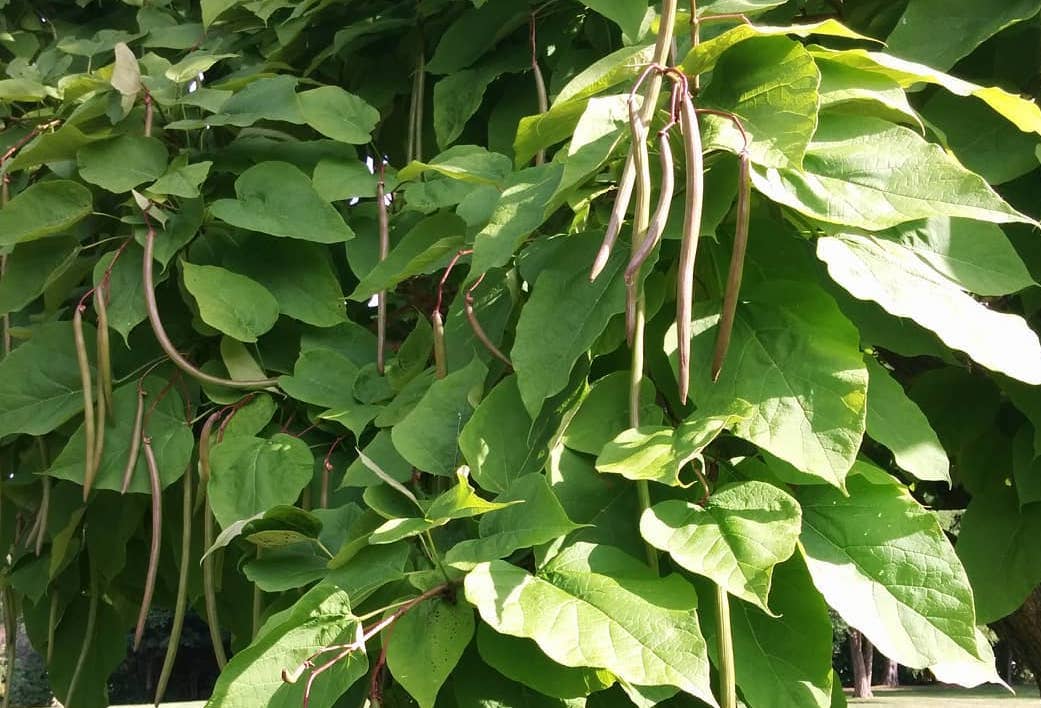
The seed pods of the catalpa tree are long and strong-bean like and persist throughout the winter in our region. Photo credit: Prescott House Museum
Privet Private Eyes: September 2021
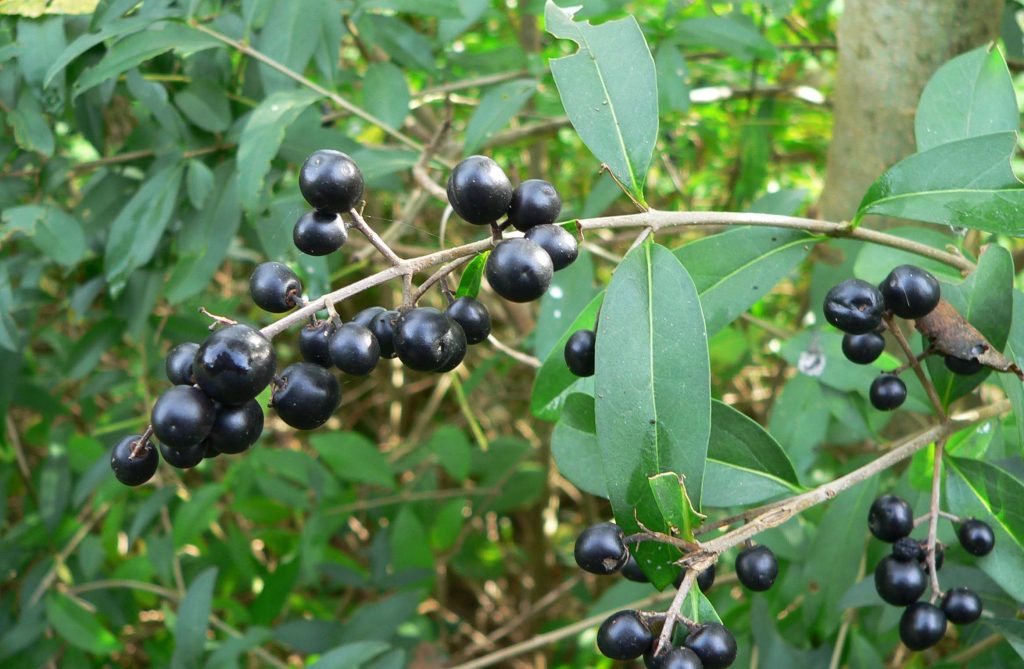
The dark black berries of invasive privets ripen in the fall in our region and grow in clusters at the tips of the branches, unlike other invasive look-alike shrubs, like bush honeysuckle, whose berries and flowers grow in pairs at the base of the leaves.
Ever dreamed of becoming a private eye? Well, now's your chance! In September's "Privet Private Eyes" EcoQuest Challenge, you get to do some sleuthing and use ID clues to help detect and report invasive privet in the lower Hudson Valley and northern New Jersey. Privet (Ligustrum spp.) consists of several species of invasive shrubs imported from Asia in the mid-1800's that were originally used as hedge plants and in landscaping. Border, common, Japanese and Chinese are all invasive privets found in our region. These invasive plants can quickly form dense thickets that alter the soil composition and habitat structure of the natural areas they invade, further promoting their establishment and spread. Privets are notable for their oval shaped, pointed-tip leaves that are arranged oppositely along the branches. Both their trumpet-shaped flowers (which appear in the spring) and their dark fruit (which start ripening in fall) grow on the tips of the branches. This growth structure differs from other invasive shrub lookalikes, like bush honeysuckle, whose fruit and flowers appear at the base of the leaves in pairs.
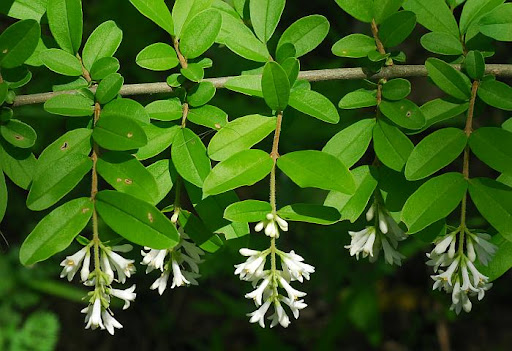
Border privet leaves are oblong in shape with a pointed tip and are arranged oppositely along the branches. Note the trumpet-shaped flowers that bloom in spring and grow on the tips of the branches. Photo credit: SR Turner, missouriplants.com
Worts and All: August 2021
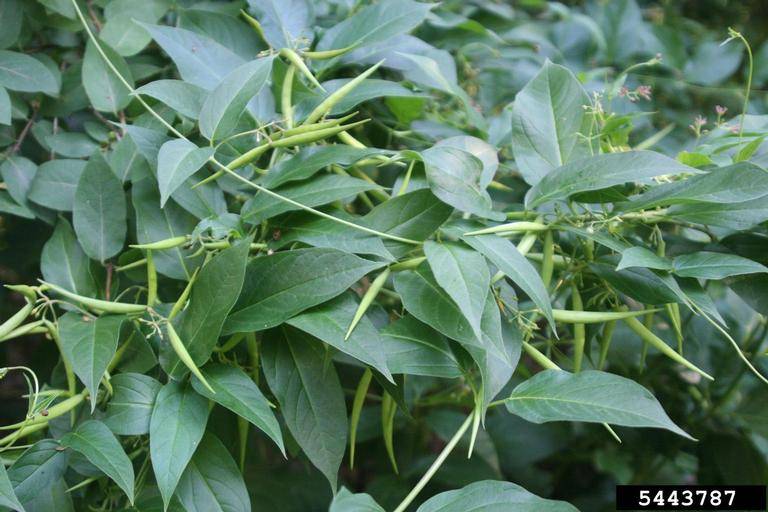
A tangle of pale swallow-wort. Notice that the dark green and glossy leaves are oppositely arranged along the stem and the presence of "green-bean like" seed pods, which should be apparent at this time of year. Photo credit: Chris Evans, Illinois Wildlife, bugwood.org
Monarch butterflies are one of the most iconic insects in North America. Their impressive multigenerational migrations from their winter grounds in Mexico to our natural areas in the Northeast follow the blooming cycles of their host plant, milkweed, which their young require for survival. But there is an impostor plant in the monarchs’ midst, invasive swallow-wort vine, which resembles milkweed in appearance and chemical composition, thus confusing the monarchs into laying their eggs on it. Despite the similarities in appearance, monarch caterpillars cannot survive on swallow-wort’s nutrients. Any eggs laid on this invasive host plant are lost. Not only this, but swallow-wort is an aggressive vine that clambers and climbs over other vegetation, stealing vital nutrients and outcompeting native plants we are trying to protect. It is nefarious, indeed.
There are two different species of swallow-wort in our region: black swallow-wort (Vincetoxicum nigrum) and the less common pale swallow-wort (Vincetoxicum rossicum). Both species have dark green glossy leaves about 3-6” long that come to a rounded point at the tip. The vine twines itself around other vegetation as well as itself in a corkscrew-like fashion. The two species can be distinguished from each other when they flower in the spring. Pale swallow-wort produces pink, star-shaped flowers whereas black swallow-wort flowers are a very dark purple with a similar 5-petaled star-shaped arrangement. At this time of year, swallow-wort is best distinguished by its seed pods which are 1.5-3” in length and thin, resembling a green bean. The inside of these seed pods are full of flat, brown seeds covered in fine, white hairs. Please make sure to watch this Swallow-wort Field ID Video created by Invasive Species Citizen Science Coordinator, Brent Boscarino, for further tips!
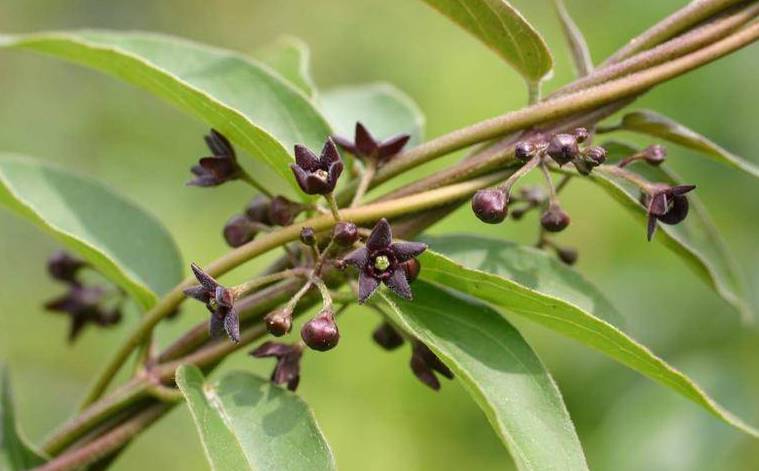
The 5-petaled star-shaped flowers of black swallow-wort are dark purple and bloom in the spring, though some plants may still retain these flowers into the fall. Photo credit: Leslie Mehroff, UConn, bugwood.org
Hop to it! EcoQuest Challenge: July 2021
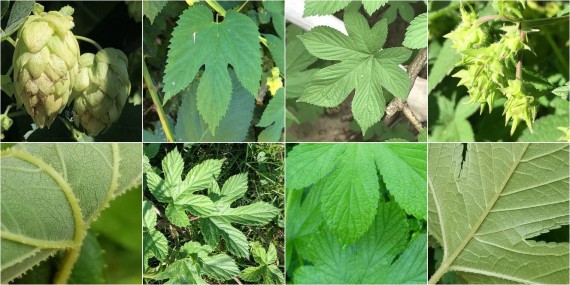
Comparison of invasive Japanese hop (cluster of 4 photos on right) versus American hop (cluster of 4 photos on left). Japanese hop leaves have 5 or more lobes (top row, third photo) with much sharper angles between the lobes (bottom row, third photo) than American hop leaves which typically have three lobes (top row, second photo) and more rounded/wider space between the lobes (bottom row, second photo). Note also that Japanese hop bracts, or modified leaf structures that hug the fruiting spikes, curve outward (top right) versus American hop bracts which tend to hug the fruiting spike in a more pinecone-like fashion (top left). Lastly, American hops have tiny oil producing glands along the primary leaf veins (bottom left) versus Japanese hops which do not (but also note that Japanese hops do have downward facing prickles but no soft oil glands). Photo credit: bplant.org
Whether you are hiking along a wooded trail or hanging out near the shore of one of your favorite lakes, we've got something for you to be on the lookout for in this month's Hop to It! EcoQuest Challenge. Our first hop-themed species is Japanese hop, an annual climbing or trailing vine that can grow up to 35 feet in one season, smothering native vegetation in the process. This invasive vine can be distinguished by its 5+ lobes on its leaves versus its beer-making native counterpart, American or common hop, which typically only has 3 lobes. Check out the other differences between these two hop species in the above photograph and caption. Please make sure to watch this Japanese hop field ID video created by Invasive Species Citizen Science Coordinator, Brent Boscarino, for further tips!
Hopping along to our next themed species, European frog-bit is a free-floating aquatic invasive plant that tends to grow well in slow-moving marshes, rivers, lake shorelines and sheltered bays. Frog-bit displays rapid vegetative spread forming dense mats that block sunlight from penetrating the water column and inhibit recreational use of waterways. This species' ID features and impacts are highlighted in the below photo and discussed in detail in this Statewide Species of Concern Webinar that was presented as part of New York Invasives Species Week. Simply hop to the frogbit portion which we have conveniently sectioned off starting at minute 39:52 of the webinar. European frogbit is also a featured species of the 6th Annual New York Invasive Species Mapping Challenge with N.Y. iMapInvasives.
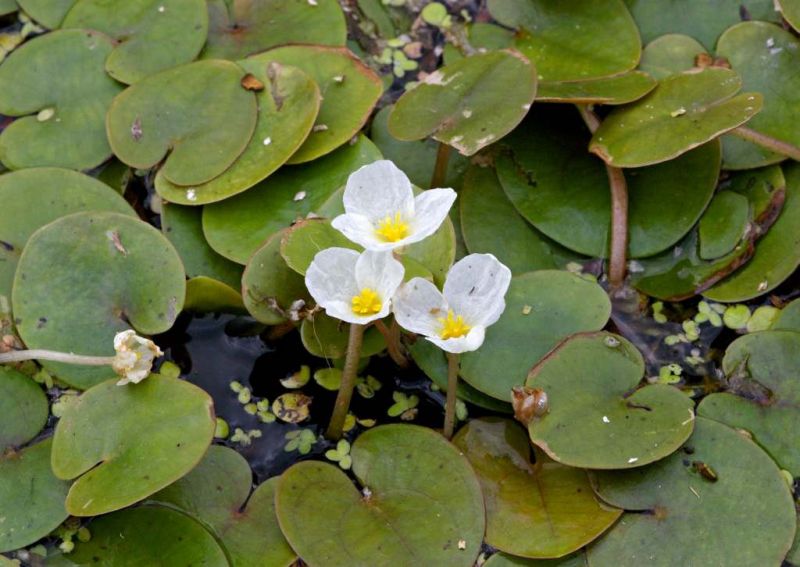
European frog-bit has small (0.5-2.5 inch) heart-shaped leaves with smooth margins. It also produces a small 3-petal slower with yellow center at this time of year in our region. New growth sprouts from trailing runners, or stolons, that form dense mats on the surface of the water as well from turions or buds that lie dormant over winter. Photo credit: vtfishandwildlife.com
BLDetection: June 2021
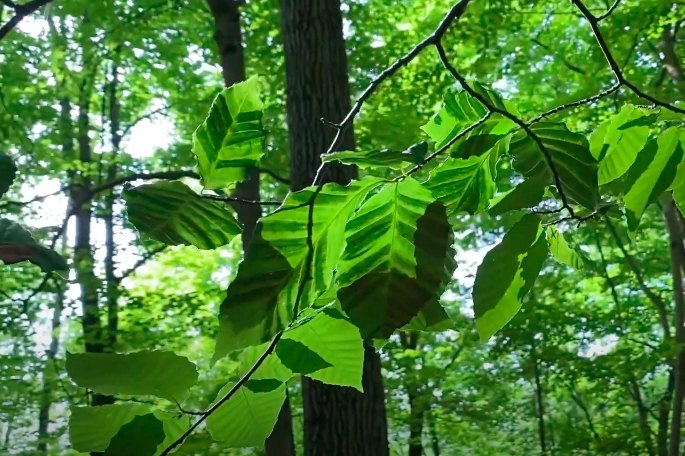
The primary diagnostic symptoms of beech leaf disease (BLD) include tissue thickening and striping of beech leaves between leaf veins; these striped bands tend to start as dark green but can later progress and may eventually turn brown and withered as they lose their ability to photosynthesize.This photo is from Granite Mountain preserve in Putnam County, N.Y. where BLD was only recently discovered in May 2021. Photo credit: Brent Boscarino
Last year, we received numerous reports and concerns about stressed and diseased beech trees in our region. We responded with a thorough investigation into what may be causing these symptoms by featuring beech health in last September’s Beech Leaf Investigation EcoQuest and by consulting with regional forestry and pathology experts and laboratories to get to the bottom of the issue. We learned that some of the stress symptoms were caused by a frost event in May of 2020 which left the leaves darkened and withered while other symptoms were the result of beech leaf disease, or BLD. We promised to continue our efforts to monitor the spread of BLD and the recovery of beech trees from that frost event by following up with another EcoQuest survey after spring leaf out in 2021- that time is now!
BLD remains an ominous threat to beech trees in our area and early reports suggest it continues to spread throughout our region. The disease is caused by a nonnative nematode worm associated with the buds and leaves of beech trees of all age classes, leading to aborted leaf development, premature leaf drop and ultimate mortality usually within 2-7 years (disease progression is typically more rapid in younger beeches). The main priority right now is on early detection and reporting in our area to better understand BLD’s current distribution and the mechanisms and rate at which it is spreading. These monitoring efforts will better enable us to make more informed, strategic management decisions on how best to curtail BLD’s impacts on our forests and to promote recovery and rehabilitation.
Check out this informational video by Invasive Species Citizen Science Coordinator, Brent Boscarino, that discusses how to ID beech trees and detect the hallmark features of beech leaf disease. For more information on how to join our monthly scavenger hunt, please contact us at invasives@nynjtc.org.
Eyes on Iris: May 2021
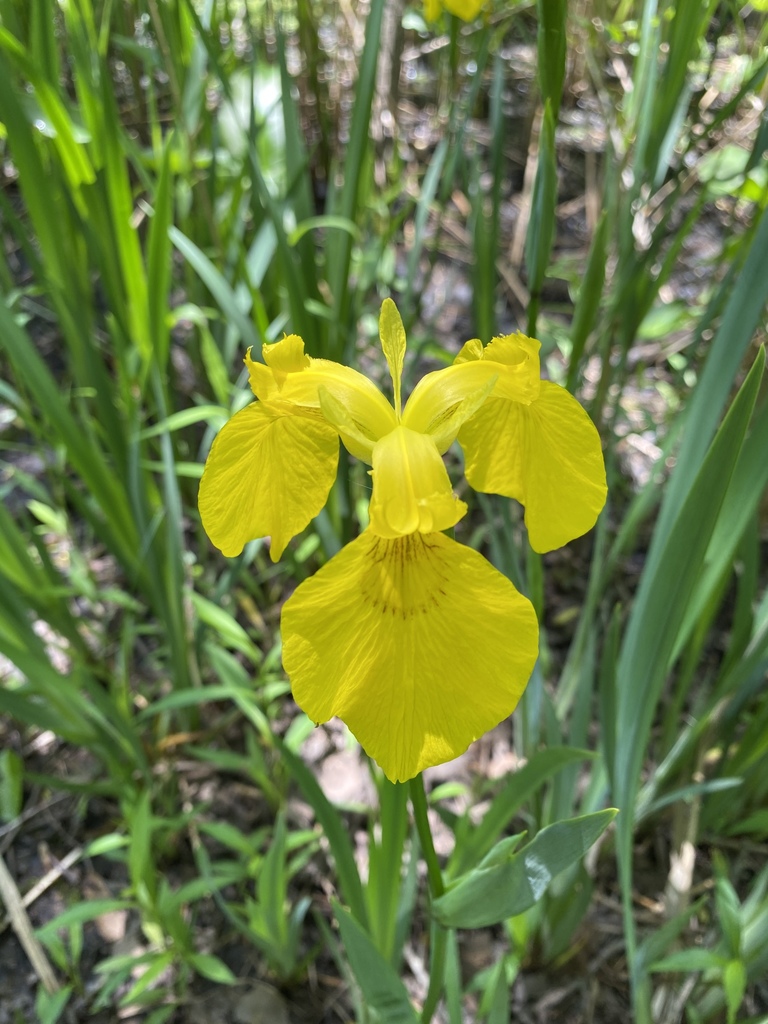
Yellow flag iris has three large downward facing yellow petals as well as 3 more upright sepals that will start blooming in our region in mid-May. It looks a bit like the Aries zodiac! Photo credit: inaturalist.org Creative Commons
As exciting as it is to see colorful blooms this time of year, don't be fooled by this yellow beauty, Iris pseudacorus, commonly known as yellow flag iris, yellow iris or water iris. This invasive plant has taken over multiple types of different habitats in our region, most often found along stream banks, ditches, floodplains and low-lying wetlands. Brought to the United States from Europe as an ornamental and to help with erosion control along embankments, yellow flag iris creates thick rhizome mats that prevent native seed establishment and dries out natural wetland and riparian habitats by trapping sediments. Its buoyant seeds and rhizome fragments can float and remain viable for 2 months in the water, allowing the plant to take root and establish far downstream from its original source. It is also toxic to most consumers.
For these reasons and more, we need your Eyes on Iris this month! The species is considered to be a Tier 4 or common species but is likely very under-reported in our region- a perfect EcoQuest candidate! While you likely will not see the yellow blooms until mid-May, there are other features you can look for in the first few weeks of May to help distinguish it from other wetland and riparian plants like native cattails and arums. To help build your ID confidence, please reference the above and below pictures and captions as well as check out this field ID video created by Invasives Species Citizen Science Coordinator, Brent Boscarino.
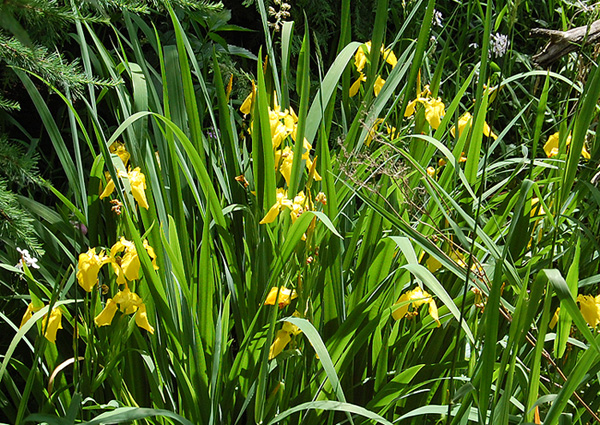
Even before blooming, you may be able to spot yellow flag iris by its clumped sword-like leaves that have smooth edges and a raised midrib. Unlike native cattails which have a similar clumping growth pattern, yellow flag iris has a flatter base of the leaves versus cattails which have a round base. Photo credit: inaturalist.org Creative Commons
Water Walk: April 2021
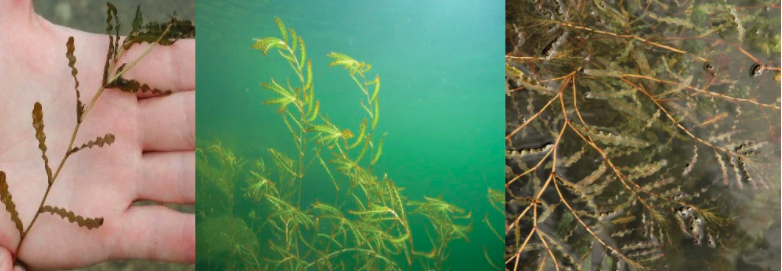
Curly leaf pondweed can be identified by its oblong leaves (4-10 cm. long) that are wavy and serrated- they look a bit like skinny lasagna noodles! Photo credit: thepondshop.com
Does your idea of the perfect spring day outdoors involve a nature walk along a stream? Enjoy picnicking with your family on the shore of a lake or pond in your community? Then you are all primed and ready to participate in this month's EcoQuest Challenge called Water Walk which will focus on two invasive species that are associated with water: the aquatic invasive species, curly leaf pondweed, and black alder, a tree typically found nearby a water source.
To participate in this month's challenge, take a look at the plant life submerged close to shore the next time you are out in a park with a water body close by. If you see a submerged aquatic plant with leaves that look a bit like lasagna noodles or bacon, then it's likely you are seeing curly leaf pondweed which typically gets a jumpstart on the growing season over native aquatic plants. As you walk along the shore of this water body, also be on the lookout for a single-stemmed tree or multi-stemmed shrub (it can grow as both!) that has both male and female catkins (flowering spikes, see picture below) and lots of raised, white bumps called lenticels. It may be an emerging invasive plant, black alder. To be sure, we recommend looking at the leaves that have fallen beneath the alder - if the fallen leaves are roundish, have toothed margins and have a stunted, notched tip (see photo below), then it's most likely black alder and not one of its native lookalikes like speckled alder which has pointed leaf tips (Note: look at multiple fallen leaves - not every black alder leaf has the notched tips so look around!). The catkins of black alder also tend to grow on longer stalks than native alders.
To help build your ID confidence, check out this field ID video created by Invasives Species Citizen Science Coordinator, Brent Boscarino. If you think you might have come across one of the invaders during your Water Walk, let us know by posting a photo to iNaturalist and help us map the distribution of these species in our region.
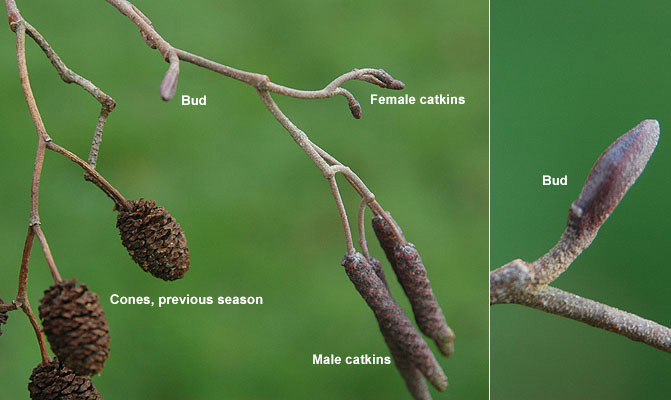
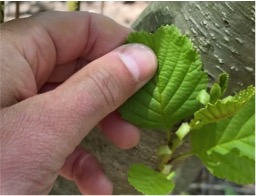
Black, or European/common alder, can be identified at this time of year by its distinctive catkins (male and female flowering structures) that can persist over winter as well as by looking for bumpy lenticels on the bark (look in the background of the photo of the hand holding the leaf). While the leaves won't be out this month, you can look for the presence of last year's leaves that have fallen off the tree and see if at least some of them are notched at the tip (pictured here is an example of the notched leaf during the growing season). Photo credits: Brent Boscarino and landscapeplants.oregonstate.edu
Heavenly Objects: March 2021
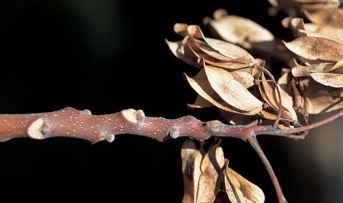
The heart-shaped leaf scars found just under the leaf buds on the newer growing branches of mature tree of heaven and young TOH saplings are good winter ID features in addition to the presence of its papery seeds which can persist in winter ad look a little like oblong eyeballs. These branches and young TOH also tend to have bumpy lenticels, often seen as white dots on the stem or branch. Photo credit: marylandbiodiversity.com
When we think of heavenly objects, maybe images of the solar system or Mars exploration come to mind (way to go Perseverance Rover!). But this EcoQuest Challenge’s Heavenly Objects refers to another type of alien in our midst – the invasive spotted lanternfly (SLF) and the egg masses it lays on its preferred host species, tree of heaven (TOH). Many of our veteran Invasives Strike Force surveyors know how to recognize TOH in the growing season, but identifying it in the winter without its distinctive smell and pinnately compound leaves requires a new set of detective skills. Tree-of-heaven’s “cantaloupe-rind” bark and heart-shaped leaf scars are two features to be looking for at this time of year. Once you’ve located TOH, we are asking volunteers to not only upload their discovery to iNaturalist, but take the additional steps to survey the tree for the presence of SLF’s putty-like egg masses and to photograph and report any possible sitings to us at invasives@nynjtc.org.
For a detailed look at the relationship between SLF and TOH including its winter ID features and variations, please check out this educational video and winter field ID guide created by Brent and you’ll be ready to start start your quest for Heavenly Objects!

Spotted lanternfly egg masses are usually about an inch wide and and a couple of inches long. Each covered egg mass can contain about 30-50 individual eggs. Photo credit: Brent Boscarino
Angling for Archangel: February 2021
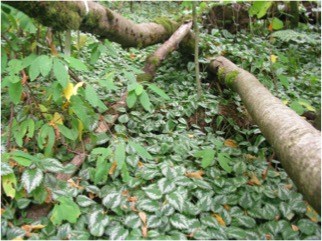
Yellow archangel, whose leaves seen here have a green center surrounded by streaks of white, can quickly take over a forest understory if it escapes cultivation. Photo credit: kingcouty.gov
Have you ever thought you found that "perfect" groundcover plant for that bare patch in your garden, only to have it quickly spread and take over your entire garden? Been fighting it ever since? Thus is the nature of invasive groundcover species like this month's EcoQuest Challenge focal species, yellow archangel (Lamium galeobdolon). Unfortunately for our native habitats and ecosystems, the impacts of invasive groundcover plants are not just limited to private properties and landscaped areas, but they are becoming increasingly problematic throughout our region's natural areas. Yellow archangel, like most invasive-type groundcover plants, can spread and come to dominate understories and gardens by sending out stolons, or runners, which are creeping horizontal stems that take root at certain points along its length. In other words, if you try to pull the plant out and break off the stem without pulling up the roots, it will just resprout. Yellow archangel also has the potential to spread up vertically in a vine-like manner over low-growing vegetation and tree stumps. But how do these groundcover species like yellow archangel go from a garden and landscaping setting to natural areas and start impacting forest understories? One way is through spreading out horizontally to natural areas from adjacent properties, but another primary mechanism for spread is improper garden and yard waste dumping, disposal and composting. It can also spread through seed and potentially attach to clothing and gear. So, if you have this species in your garden and want to get rid of it, be careful to dig out the shallow roots and dispose of the plant in bags destined for the landfill.
Key ID features
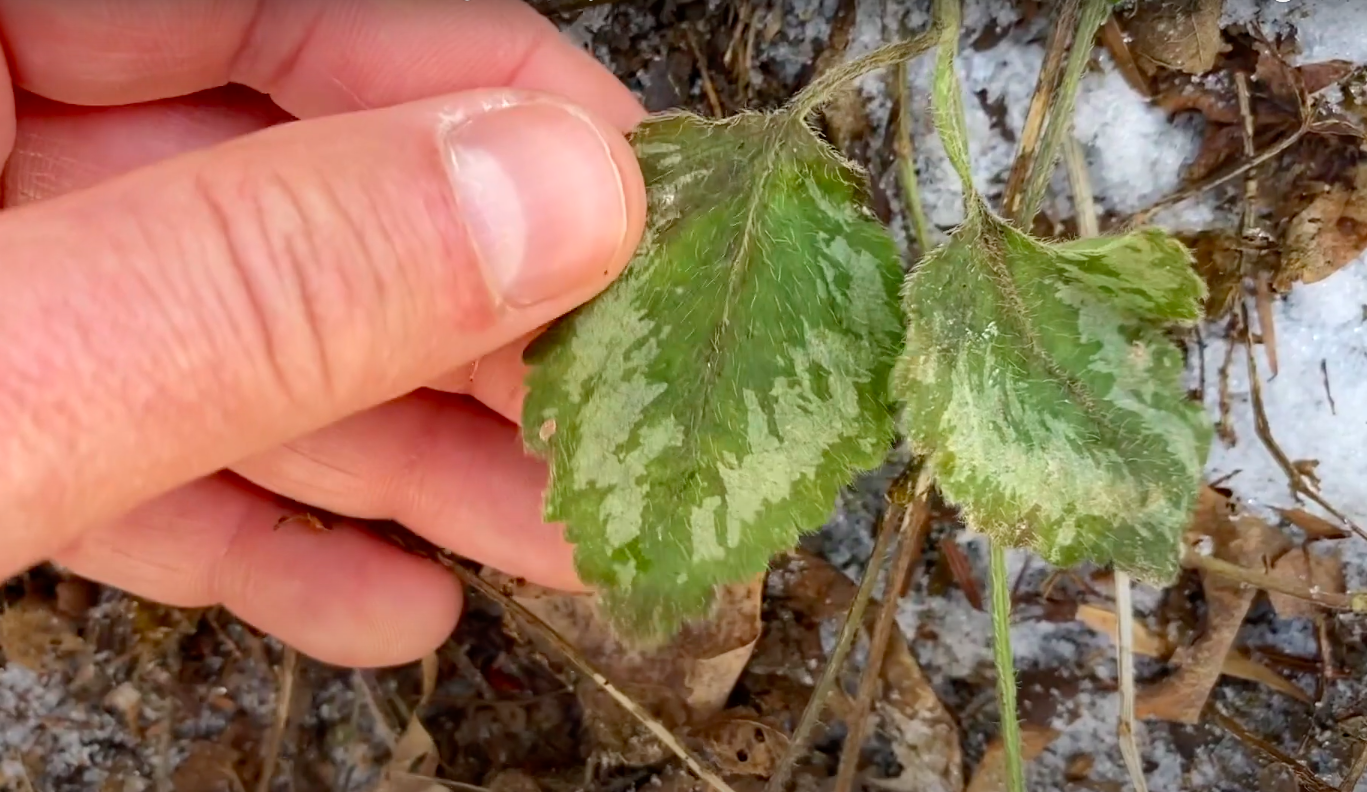
Yellow archangel's opposite leaf arrangement, splotchy white coloring, hairy surface, and coarsely rounded toothed margins are all still prominent in the winter. Sometimes the center of the leaf can take on a darker/black hue in the winter versus its typical, standard green. This photo was taken in the winter when the green is less vibrant than during the main growing season.
Yellow archangel is a type of dead nettle and is also in the mint family, which is characterized by its square-ish stems and of course its smell (the leaves of yellow archangel can produce a faint aroma of mint when crushed during the growing season). Why is it called yellow archangel, you might ask? That's due to its leaf shape and opposite leaf arrangement which resembles angel's wings! The coloration on the leaves is referred to as variegated, or exhibiting irregular patches or blotches of color. Most of the yellow archangel in this region have silvery-grey to white streak marks/blotches on top of its green base color. The leaves are coarsely toothed and tend to come to a rounded point at the tip. It produces yellow flowers that grow in pairs close to the stems which can grow up to 1-2 feet tall. You won't see the flowers at this time of year though, as the plant blooms in the spring. The main features you are looking for at this time of year are the silvery grey to white streaks, toothed edges, hairy surface and angel wing-like appearance to its oppositely-arranged leaves. Check out this field ID video made by Citizen Science Coordinator, Brent Boscarino for more details on how to ID yellow archangel in the winter!
While yellow archangel is not currently listed as invasive in the Hudson Valley and northern New Jersey, it is considered a noxious weed and highly invasive in other parts of the U.S., especially in the Northwest. It is currently listed as a Tier 5 species (on our LH-PRISM's "watch" list) meaning it is a species that has exhibited invasive tendencies in other regions and that more information and research is needed on its distribution and impact in our region. A great candidate for our EcoQuest Challenge!
Taboo Bamboo!: January 2021
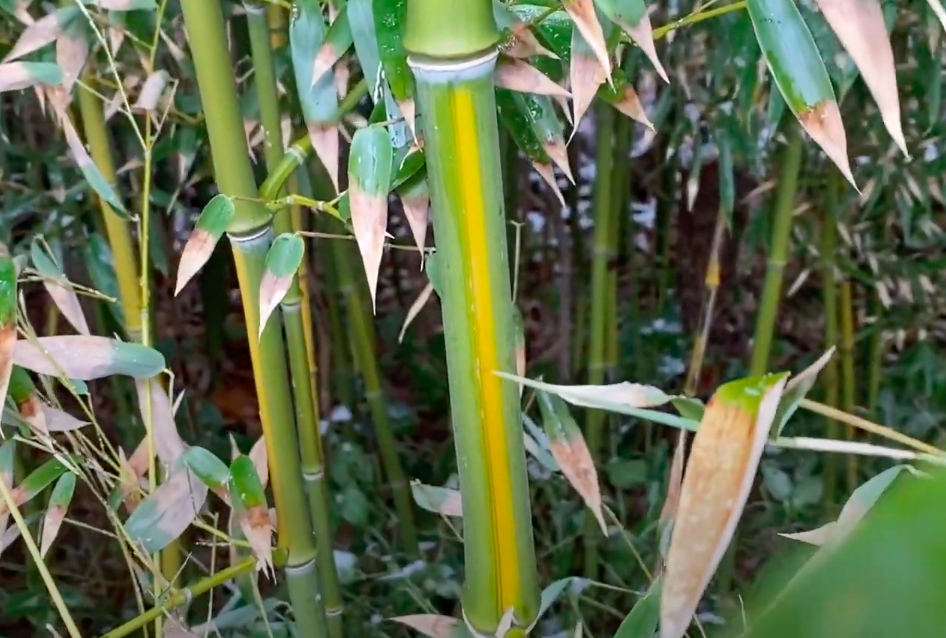
The yellow-stripe sulcus groove is a hallmark feature of yellow groove bamboo.
Are you a frustrated homeowner whose neighbor's landscape bamboo has spread to your own property? Have you seen bamboo growing along a roadside or in a natural area and are worried about how it might impact that ecosystem? Then join this month's EcoQuest Challenge where we will focus on two species of bamboo that are currently on the prohibited list of invasive species in New York State: yellow groove bamboo (Phyllostachys aureosulcata) and golden bamboo (Phyllostachys aurea). These two species are types of “running bamboo” which can spread quickly through rhizomes, or underground modified horizontal stems that can strike out roots at lateral intervals as well as new stems up vertically through the soil.
One of the distinguishing ID features of these Phyllostachys bamboos is a groove, called a sulcus, found just above each joint, or node, on the bamboo stem. These grooves appear as concave notches, or partially hollowed out portions of the stem that run between the nodes. In yellow groove bamboo, these grooves are yellowish in color on every other internode (or segment between nodes), especially in younger bamboo stems (see photo above). This yellow groove stripe tends to fade as the bamboo matures. Yellow groove bamboo also has a slightly rough, sandpapery feel to the stem if you run your hand upwards. Occasionally, you may see a zigzag-like growth pattern to the lowest few internodes on yellow bamboo which is not a feature of most other species of bamboo (although not EVERY yellow groove bamboo stem has this growth pattern- see photo below).
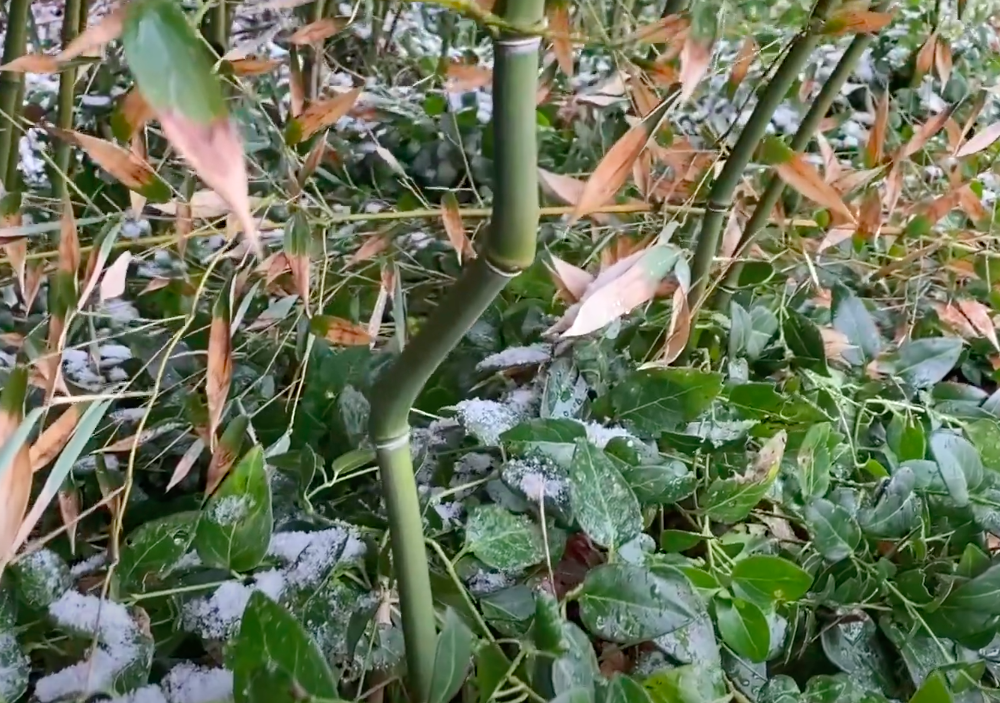
The zigzag-like growth pattern to the base of some yellow groove bamboo.
Golden bamboo can be identified by its more yellowish to golden stems (versus the more greenish hue of yellow groove bamboo), though stem coloration can vary from stem to stem. One distinguishing feature of golden bamboo is that in SOME of the stems, you may see distinct, swollen internodes that are bunched up together at the bottom of random canes. While this is not featured in each stem, look around within the bamboo patch to see if you can find any stems that have this characteristic (seen below).
These and other features are summarized in this video presentation by Invasive Species Citizen Science Coordinator, Brent Boscarino. Please check it out! We are primarily looking to upload photos of escaped bamboo and along roadsides and in natural areas, NOT necessarily on private property. If you do upload photos from a property, please mark as "cultivated" in iNaturalist! Good luck hunting for these taboo bamboos!
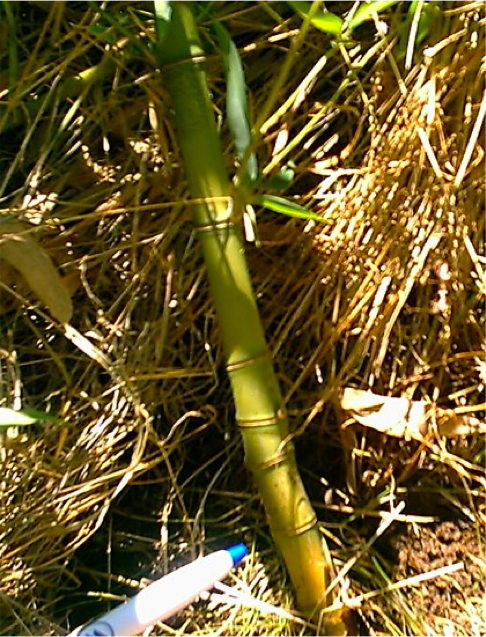
Compressed internodes on some random canes of golden bamboo. Photo credit: Caryn Rickel
Learn How to Reed! December 2020
A look at an invasive common reed monoculture stand in winter. Photo credit: massaudubon.org
Have you noticed that many of our region’s wetland habitats and riparian zones are dominated by dense stands of only one type of tall reed grass? Wondered what it is or whether it’s a problem? It is very likely you are looking at invasive common reed, Phragmites australis ssp. australis, a perennial grass that has overtaken many of our natural riparian and wetland landscapes, adversely impacting native plant and wildlife diversity in the process. In this month’s EcoQuest Challenge, we are asking volunteers to be on the lookout for this nefarious invader as well as its native counterpart, American common reed (Phragmites australis ssp. americanus). We are adding this native species to this month’s EcoQuest because it is far less common, is likely underreported in our region and we need your help in finding it so that land managers do not unknowingly eradicate it thinking it is the invasive subspecies! We know you are up to the challenge!
Both types of Phragmites have tall, stiff erect stems that can grow up to 15 feet high and are tannish brown at this time of year. At the top of each stem are obvious influorescence heads that tend to droop to one side and are about a foot or more in length. The leaves grow alternately along the top half of the stems, are about 1+” wide and taper to a point, resembling a scythe blade. One way to tell apart the two subspecies is by looking at the influorescence heads. Invasive Phragmites influorescences tend to be much fuller and more branched than the sparser and less branched appearance of native Phragmites. Another way to distinguish between the two subspecies is by looking at its lower stems. The culm, or inner stem, of Phragmites is covered by a protective sheath during the growing season. In late fall/winter, that protective sheath will begin falling off and/or is not tightly attached to the culm in native Phragmites. The protective sheath in invasive Phragmites typically remains tightly attached to the culm in multiple overlapping layers that are more difficult to peel off throughout the winter.
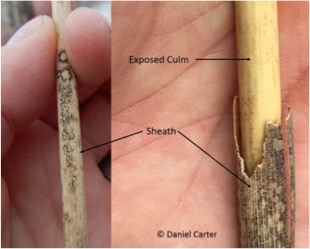
The inner stem, or culm, of Phragmites is covered in a sheath during the growing season. At this time of year, native Phragmites will have lost most of its sheath or it is in the process of falling off/easy to peel. The sheaths of invasive Phragmites tend to adhere tightly to the culm in multiple overlapping layers. Photo credit: Daniel Carter, prairiebotanist.org
Another distinguishing feature to examine is the culm itself (once the sheath has been peeled back to expose it). Native Phragmites culms tend to be smoother and shinier, whereas invasive Phragmites are a little rougher when rubbed, with raised ridges running parallel to the stem’s axis. Lastly, you can look for the presence of circular black fungal spots on the culms of native Phragmites but these circular black fungal growths are rarely, if ever, found on invasive Phragmites. These spots are not to be confused with mildew, which appears on both subspecies, and has more of a sprawling growth pattern and not organized into distinctly round circles.
These and other features, as well as an introduction to the invasion history and ecology of Phragmites, are summarized in this video presentation by Invasive Species Citizen Science Coordinator, Brent Boscarino. Please check it out! We also found this webpage from the Prairie Botanist blog very helpful. It contains links to other short field videos that highlight the winter ID differences specifically and was a good informational resource for use in creating this post and presentation. Thank you to Dr. Daniel Carter for his work on developing those resources!
Best of luck EcoQuesters. Have fun “Learning How to Reed!”
The Buckthorn Stops Here! November 2020 EcoQuest Challenge
Common buckthorn leaves have toothed margins and 3-5 pairs of leaf veins that curve towards the tip of the leaf. Note how the leaves are arranged ALMOST (but not quite!) opposite of one another on the stem. Photo credit: Paul Wray, Iowa State University.
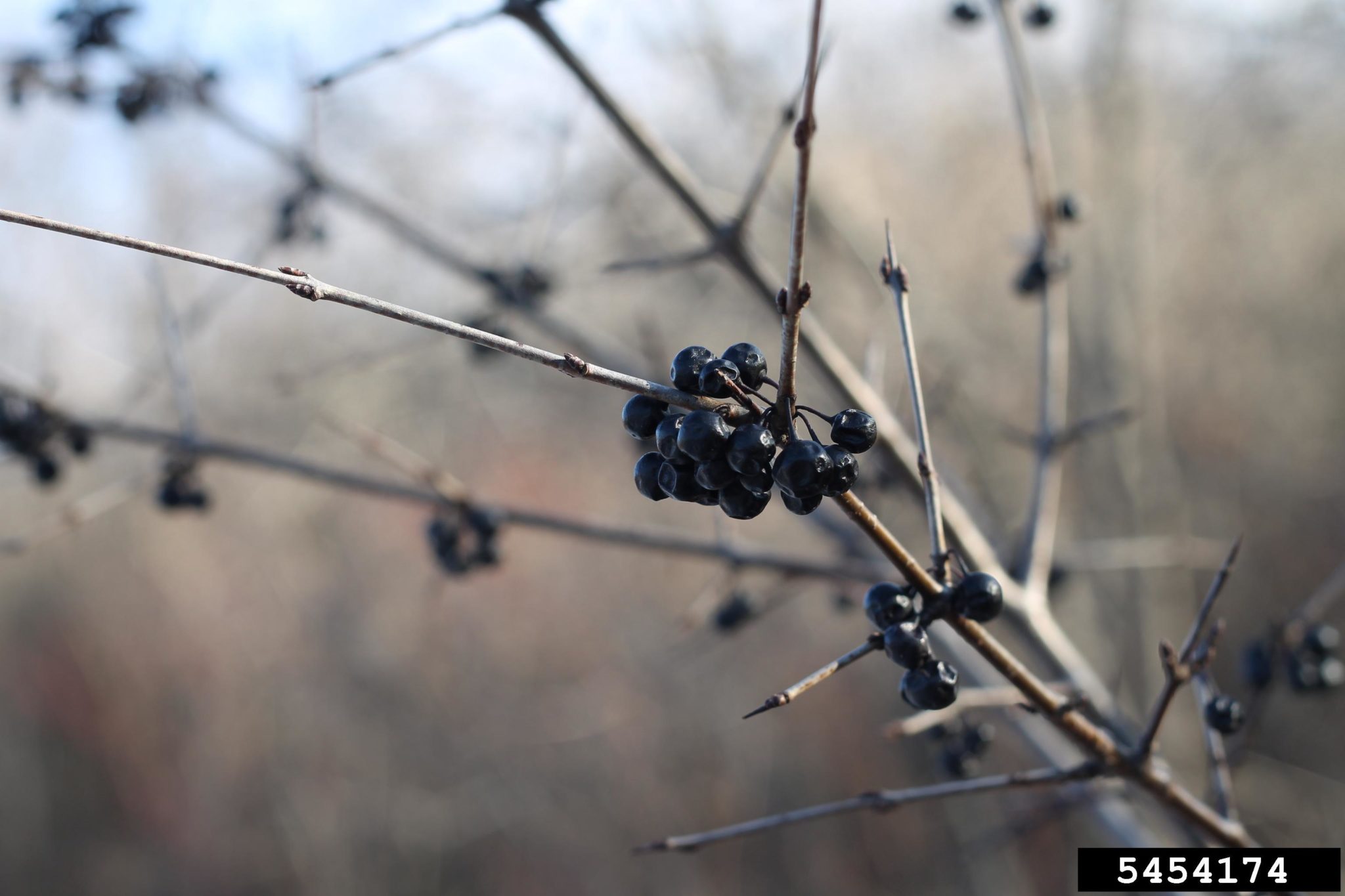
Common buckthorn can have persistent round, dark berries throughout the late fall and winter. Note the spear-like thorns at the end of the twigs- another key characteristic of buckthorn. Photo credit: bugwood.org
While many of our beloved native plants have already lost their leaves and green color, there are many invasive species that “buck the trend” of leaf and color loss in late fall. This month’s focal species (common and glossy buckthorn, Rhamnus cathartica and Frangula alnus, respectively) are two such examples of hardy invasive shrubs that tend to hold their leaves longer, retain their green color longer and show more persistent berries than their native counterparts. At this time of year, both buckthorn species may have round black berries on them that tend to grow in clumps (if the plant is female). Common buckthorn leaves are usually arranged NEARLY opposite to each other on a branch, have toothed edges and 3-5 pairs of prominent veins that curve towards the tip (see above photo). Also be on the lookout for spear-like thorns that are often found at the tip of their twigs (see above photo!) Glossy buckthorn leaves do NOT have toothed edges and have 8-9 pairs of veins (see photo below). To learn more about these and other diagnostic ID features of buckthorn in the field, watch this Fall/Winter ID video created by Invasive Species Citizen Science Coordinator Brent Boscarino and/or between minutes of 14:26 and 19:25 of this Invasives Strike Force Intermediate training workshop webinar which focuses on both of the invasive buckthorn species on our EcoQuest list for this month. PRISM partner, Beacon Institute for Rivers and Estuaries, also created this fun, shorter field ID video that focuses on common buckthorn. Lots to choose from! Help us spot these invaders and report their distribution by joining our EcoQuest today. The buckthorn stops here!
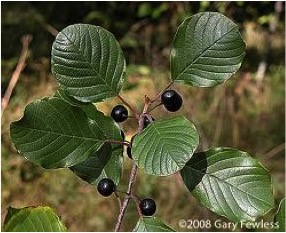
Glossy buckthorn contains more paired leaf veins than common buckthorn and does not have toothed margins on its leaves like common buckthorn does. Photo credit: Gary Fewless, bugwood.org
Can't Miss Miscanthus!: October 2020
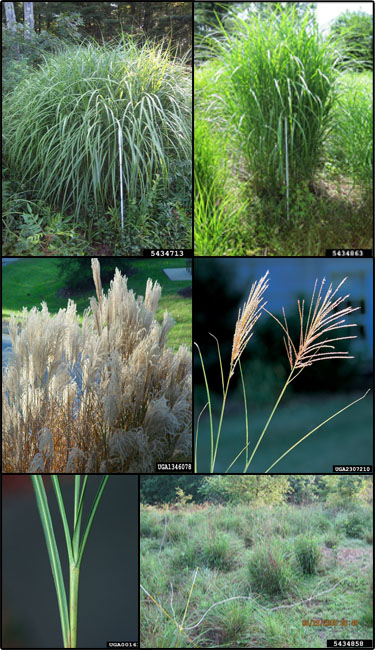
Photo credit: bugwood.org; misin.msu.edu
Calling all EcoQuest volunteers! October is upon us and as you are out enjoying the beautiful leaf-peeping season, you can participate in this month's EcoQuest Challenge, Can't Miss Miscathus!, which will track the distribution of an emerging invasive perennial grass, Miscanthus sinensis, or Chinese silvergrass. Miscanthus is a popular ornamental grass with a clumping growth pattern (above photo top row) that is escaping cultivation and beginning to negatively impact native biodiversity in natural areas in northern New Jersey and the Lower Hudson Valley. Miscanthus comes in a variety of cultivars as an ornamental, but most of the naturalized (escaped and established) populations in our region can be identified by its leaves that contain a diagnostic longitudinal white stripe along the midrib (see above photo, bottom left). Another key identifying characteristic is the flowering head of Miscanthus that resembles a pinkish/tannish feathery brush (see above photo, middle row) and usually will have silky white/silver hairs and bristles on the seed head at this time of year (see below photo). To learn more about these and other diagnostic ID features of Miscanthus in the field, check out this ID video that also relates how to tell it apart from other look-alikes that you may come across. Finally, a quick note that we are only looking for posts of Miscanthus outside of a garden/ornamental setting. Happy hunting!
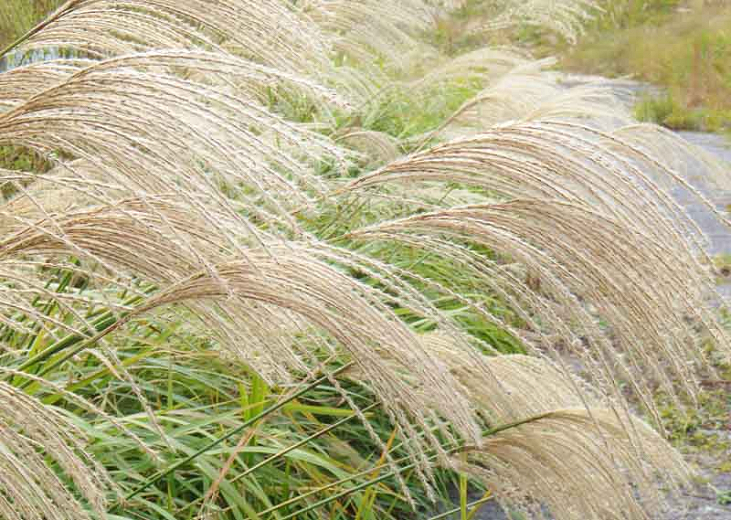
Photo credit: gardenia.net
Beech Leaf Investigation: September 2020
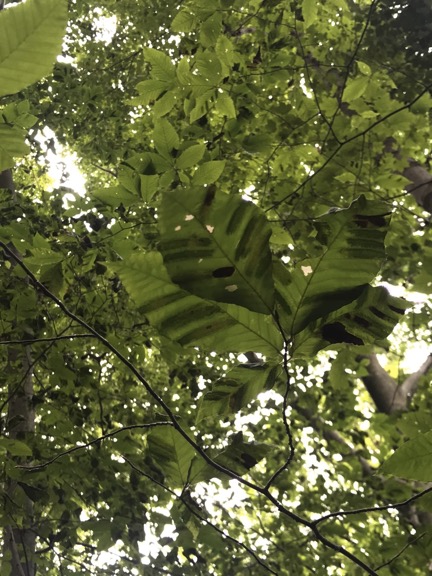
The telltale striped banding pattern of BLD in the Frederick P. Rose Preserve in Waccabuc, NY. Photo credit: John Zeiger, Westchester Land Trust
One of the more worrying patterns emerging from anecdotal and official reports from volunteers and partners in the field concerns the health of beech trees in the lower Hudson Valley. Many of our region’s beeches are showing signs of stress, with numerous reports of leaves curling up, darkening, and eventually withering and falling off, thinning out the canopy. These symptoms are not only being seen in older beech trees, but young saplings as well.
Beech leaf disease (BLD) is one possibility that scientists and land managers are exploring as a potential explanation for the symptoms being reported in our region. BLD was first discovered and reported in 2012 in Ohio but has expanded its distribution to include parts of Ontario, and Connecticut as well as Westchester, Suffolk and Rockland counties in New York State. The primary diagnostic symptoms of BLD includes striping of beech leaves between leaf veins; these striped bands tend to start as dark green and later progress to lighter green, then brown and withered as they lose their ability to photosynthesize (see photo above).
Adding more complexity to this issue are recent reports of large swaths of beech trees in portions of Fahnestock State Park and Granite Mountain Preserve in Dutchess County, N.Y. that are showing similar signs of beech leaf distress (i.e., turning dark green, rolling/curling and withering of leaves- see photo below). However, many of these symptomatic trees in Dutchess County lack the clear diagnostic banding and striping that would point to BLD. Other possible culprits include beech anthracnose (a fungus that causes necrotic growths and a brown, scorched look to the leaves) or eriophyid mites that cause a lightening of leaves on the topside and dimpling on the underside. Another prevailing hypothesis is that the leaf curling and darkening of the leaves (without the other disease symptoms described above) is the direct result of freeze and snow events that occurred in early May of this year. If this is the case, we can hope that the beeches may recover next year, but that growth and potentially beech nut set will have been significantly impacted.
This September’s Invasive Strike Force EcoQuest Challenge is focused on beech leaf health in an attempt to determine how widespread this problem is in our region. If you see beech trees showing any signs of striped banding OR multiple curled up dark green leaves (see photo below) on a given beech tree, please post to iNaturalist under “Beeches”. Make sure to check out this informative video created by our Invasive Species Citizen Science Coordinator, Brent Boscarino, on some tips for how to ID beech trees and how to tell it apart from other lookalikes as well as what symptoms/diseases to be looking for! You can also find a great presentation done by Joyce deVries Tomaselli of Cornell Cooperative Extension- Dutchess County with a lot of helpful, detailed tips and information on BLD or you can visit the Ohio State Buckeye Yard and Garden onLine website for good information and photographs on different diseases afflicting beech trees.
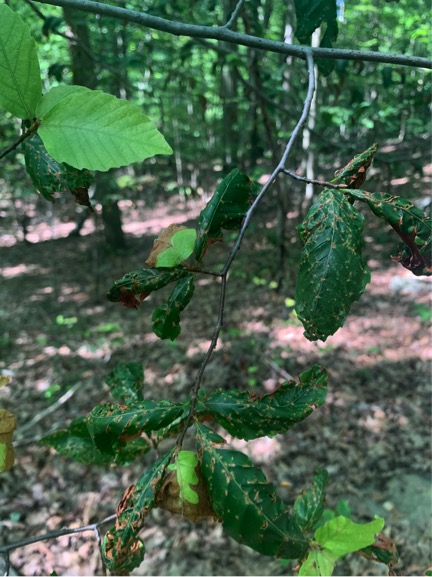
The withered, dark green appearance of beech leaves in the Granite Mountain Preserve, next to an asymptomatic beech leaf (top left) for reference. Most beech trees in Granite Moujntain and in certain areas of Fahnestock State Park are presenting this withered, crinkled dark green appearance minus the striped bands suggestive of BLD. These symptoms may be the result of frost and snow events that happened in early May of this year. Photo credit: Julia Rogers, Hudson Highlands Land Trust
Browsing for Blue: August 2020
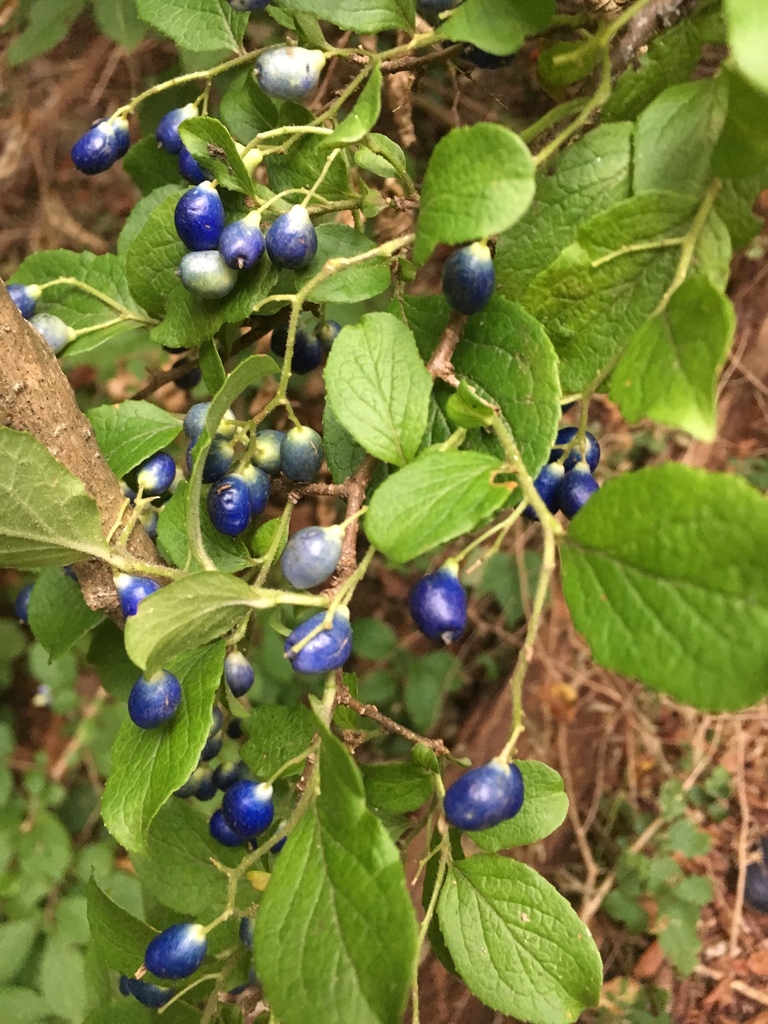
The brilliant blue color and oval shape of mature sapphireberry fruit is highly distinctive. Sapphireberries typically begin turning this radiant blue (immature fruit is green) in late summer and into early fall. If you see a plant with this color berries, be sure to look for oblong leaves which will have a rough feel to them and have tiny serrations on the margin to further confirm that it is sapphireberry. Photo credit: Keri VanCamp
This month, we are asking our volunteers to be on the lookout for any type of blue-colored berries, with a particular eye out for an emerging invasive species in the Lower Hudson PRISM region, sapphireberry. Sapphireberry, also known as Asiatic sweetleaf, is a deciduous shrub that can grow to heights greater than 20 feet and is most clearly identified by its brilliant, sapphire-colored berries that mature in late summer into early fall in the lower Hudson Valley. The oblong, simple leaves of sapphireberry are alternately arranged and have a rough, sandpapery feel to them. The margins or edges of the leaves have minute serrations on them as well which help distinguish them from native wild blueberries and huckleberries which have smoother leaf margins.
Make sure to check out this informative video created by our Invasive Species Citizen Science Coordinator, Brent Boscarino, on some tips for how to spot sapphireberry and how to tell it apart from other plants that may be "showing blue" at this time of year like wild blueberries and invasive porcelainberry! While the focus for this month is on sapphireberry, we encourage you to search for and post photos of any plants that are showing blue berries in August and into early fall! Don’t forget that you can also use the Seek app (which can help with your initial ID in real time!) if you’d like a little more of a confidence boost in your ID skills prior to posting the picture to the iNaturalist app. Sometimes this dual method helps alleviate some of the guesswork associated with initial picture angles and photo distances when photographing on the iNaturalist app.

